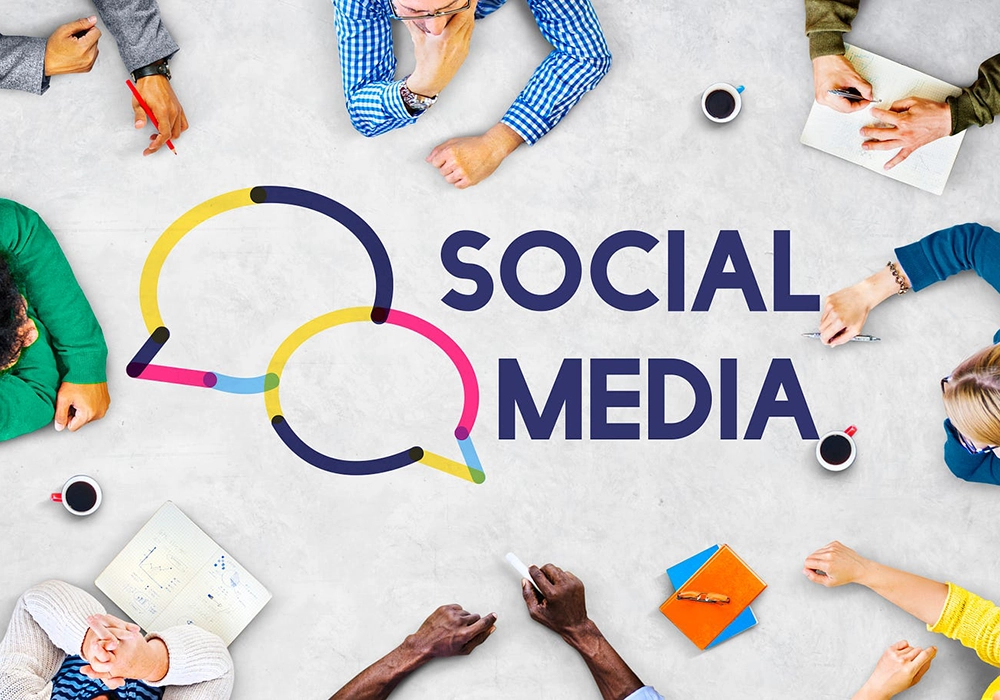Leverage Social Media for Business
Social media has become an integral part of modern marketing. With billions of active users across platforms like Facebook, Instagram, Twitter, LinkedIn, and more, social media provides unparalleled opportunities to build brand awareness, connect with customers, drive traffic, and boost sales.
This guide will explore ten proven tactics to leverage the power of social media to achieve your marketing and business objectives.
Key Takeaways:
- Choose the right social media platforms for your brand and goals
- Create engaging, valuable content tailored to your target audiences
- Utilize influencer marketing to expand reach
- Leverage paid social advertising to get in front of more users
- Analyze metrics to refine your social media marketing strategy
- Foster social media communities and encourage shares, engagement
- Incorporate email marketing with your social efforts
- Maintain consistent branding and messaging across channels
- Monitor mentions and listen to customers
- Develop an integrated social media marketing plan tied to business goals

Properly leveraging social can increase website traffic, raise brand awareness, improve customer loyalty, drive sales, and boost overall business growth.
1. Choose the Right Platforms
With so many social media sites and apps available, it can be challenging to determine where to focus your efforts. The key is choosing the platforms that best align with your target audiences, content format, and goals.
For most brands today, having a presence on major networks like Facebook, Instagram, Twitter, LinkedIn, YouTube, Pinterest, and TikTok is essential. You can also explore up-and-coming sites like Snapchat, NextDoor, or Clubhouse.
When deciding which platforms to prioritize, consider:
- Where does your target audience spend their time? What platforms and features do they actively use? Tailor efforts around user behavior.
- What type of content will you create? Choose networks that align with the content format – videos for YouTube/TikTok, visual content for Instagram/Pinterest, and discussions for Facebook/Twitter/LinkedIn.
- What are your goals? Lead generation could prioritize LinkedIn. Brand awareness and traffic may focus on Instagram and Facebook. Use platform strengths to your advantage.
As part of your social media marketing strategy, determine the right mix of networks to meet business objectives. You don’t have to be everywhere – it’s about being where your audience is and creating the right content for those platforms.
2. Create Valuable, Engaging Content
Quality content is critical for successful social media marketing. To attract and retain followers, you must create content that provides value, entertains, educates, inspires, or helps your target audience.
Consider these content creation tips:
Know your audience – Study your followers and customers. What information or content do they want and need? What problems can you help solve? What interests them? Use data and listening to fuel content.

Offer variety – Post different content types – videos, images, polls, articles, Q&As, etc. Variety keeps followers engaged across their customer journey.
Educate and entertain– Helpful “how to” posts are viral, as is entertaining or emotionally compelling content. Find the right mix for your brand.
Utilize user-generated content– Repost customer photos/videos and curate other branded content generated by users. This builds engagement and credibility.
Optimize for each network – Tailor content for how users interact on each platform. For example, vertical video works best on TikTok, brief captions are essential on Twitter, and long-form posts resonate on LinkedIn.
Maintain brand voice – Stay true to your brand identity. Content should align look, feel, and messaging for cohesion across networks.
Post consistently – Commit to regularly sharing new content that brings users back frequently. Posting cadence can vary by platform.
Spending time crafting the right social content ensures you attract and engage the right followers to support business goals.
3. Influencer Marketing

Influencer marketing on social media is big business because it taps into the power of relationships and word-of-mouth recommendations.
Marketers partner with influencers – individuals with an established social media following and niche expertise your target market knows and trusts. Aligning your brand with relevant influencers provides several benefits:
- Expanded reach – Influencers significantly expand your potential audience. Their established following represents pre-qualified leads more likely to engage you.
- ** Increased awareness** – Influencers raise awareness by introducing your brand to their engaged social audiences. This amplified word-of-mouth exposure drives credibility.
- Higher conversions – Followers are likelier to take action (purchases, site traffic, sign-ups) when influencers recommend versus brands pushing a direct message.
- Valuable content – Collaborate with influencers to co-create content like social posts, blogs, and videos that tap into their expertise and personality.
To identify potential influencer partners, use tools like BuzzSumo, Upfluence, Traackr, and Little Bird that provide influencer discovery and analysis capabilities. Look for relevant voices with engaged audiences that align with your buyer personas.
4. Paid Social Media Advertising

While organic posting is essential for nurturing existing brand followers, paid social media advertising helps you expand your reach to find new audiences.
Social platforms make it easy to set up and optimize highly targeted ads to reach more of your ideal customers where they are already spending time online.
Benefits of investing in paid social campaigns include:
- Lower cost per lead/customer – This is a very affordable way to acquire leads and sales compared to other paid digital channels.
- You are targeting precision – Dial your ideal buyer demographics, interests, behaviors, location, and more.
- Platform scale – Billions of active monthly users allow you to reveal more qualified traffic.
- Retargeting options – Remarket across social and the web to users who previously engaged you.
- Powerful analytics – Robust analytics provide campaign insights to optimize efforts and ROAS.
- Flexible budgets– Scale up and down to meet business needs and targets.
When using paid social advertising, focus the budget on one or two proven platforms rather than spreading efforts thinly across every network. Monitor results and double down on winners.
5. Analyze Key Metrics
Monitoring performance data and Basing decisions on key analytics are essential to improve social efforts’ ROI.
Critical social media metrics to track include:
- Follower growth over time across chosen platforms
- Engagement rates on posts (likes, comments, shares, clicks)
- Impressions and reach for organic vs. paid content
- Website referral traffic from social channels
- Conversions from social referrals (form fills, purchases, etc.)
- Sentiment analysis of social mentions and feedback
- Customer acquisition costs on paid social ads
Based on performance data, identify best practices for your brand across content, influencers, hashtags, posting cadence, creativity, and more. Continual optimization is vital.
Top analytics tools like Sprout Social, Hootsuite, RivalIQ, Iconosquare, and BuiltWith provide easy-to-use dashboards to help analyze and improve your social media success.
6. Foster Social Communities
The most influential social media brands are developing and nurturing online communities. They spark ongoing conversations and relationships with their highly engaged followers.
You can foster brand communities across all social channels by:
- Responding to ALL comments and questions on your posts helps make connections. No comment should be ignored.
- Asking engaging questions to followers in your posts encourages two-way dialogue.
- Sharing user photos and videos related to your brand helps build engagement. Credit all creators.
- Running polls or contests centered around fun hashtag campaigns inspires audience participation.
- Use Stories features on Instagram, Facebook, LinkedIn, and Snapchat to give personality-driven, authentic peeks into your brand.
- Giving social media followers early access to sales, special offers, or new products helps build loyalty.
- We celebrate customer success stories, user-generated reviews, and testimonials to highlight social proof.
Foster the relationships and community feel that social channels naturally facilitate. This boosts participation, satisfaction, advocacy, and sales over the long term.
7. Integrate Email Marketing

While social media excels at driving brand engagement, email marketing enables deeper follower connections to convert interest into sales ultimately. Drives brand engagement, email marketing enables deeper follower connections to
Bring these two strategies together by:
- Collecting email addresses – Use website pop-ups, landing pages, and social channels to gather email contacts for subscriber lists.
- Promoting signup offers – Run social ad campaigns with lead magnets/freebies to entice email sign-ups.
- Repurposing social content – Adapt popular social posts into email newsletters, promos, and drip campaigns.
- Driving traffic to social – Embed social sharing buttons, links, and plugins into email content to increase followers.
- I am using mail targeting – Email subscriber segments without social followers yet with network-specific signup CTAs.
When appropriately coordinated, email and social efforts combine as a decisive 1-2 punch to drive greater brand exposure, revenue, and loyalty in the long term.
8. Maintain Consistent Branding

One common branding mistake on social media is networks looking disjointed and disconnected. This confuses followers when the visual identity and messaging don’t align.
Important branding continuity tips:
- Adhere to the same logo, color scheme and graphics across all channels
- Keep profile imagery consistent – profile picture, header, icon
- Sound recognizably like YOUR brand via tone of voice in captions
- Stick to core brand values and purpose in all posts
- Avoid overly sales-y pitches on social channels
- Link to website and other social profiles to facilitate network discovery
Consistent social branding builds recognition, trust and loyalty. Followers come to expect and appreciate your unique personality. A steady stream of branded content starts to stand out on noisy feeds.
9. Listen and Monitor Mentions
Actively monitoring social media conversations through listening allows you to hear feedback and identify mentions.
This enables real-time response to:
- Answer questions or concerns swiftly
- Jump into related conversations
- Thank followers for shares and check-ins
- Monitor campaign hashtags and trends
- Address negative commentary professionally
- Spot user-generated content to amplify
- Gather testimonials and reviews
- Provide social media customer service
Best practice is to monitor conversations across all social channels daily. Top listening tools include Hootsuite, Sprout Social, Mention and Talkwalker.
This helps you protect brand reputation, boost engagement and gain insights to improve marketing.
10. Build An Integrated Social Media Marketing Plan
The most effective approach is developing an overarching social media marketing plan that integrates with broader business goals and other marketing channels.
This unified plan should outline:
- Objectives – what specifically you want social efforts to achieve
- Target buyer personas – detail the audience you plan to target
- Content strategy – the types of content you’ll create and share
- Paid advertising approach – how much budget you’ll allocate to paid
- Platform mix – where you’ll focus posting efforts
- Engagement tactics – how you’ll encourage audience participation
- Analytics plan – which metrics you’ll measure for optimization
- Email integration – how you’ll coordinate email with social
- Campaigns – promotions and hashtag initiatives to boost awareness
- Team roles – who will own managing, posting and monitoring
- Reporting cadence – how often you’ll evaluate efforts vs. targets
With an integrated social media marketing plan guiding efforts, you’ll maximize impact and return across chosen platforms.
Adjust the plan quarterly based on performance data, platform trends, competitor activity and business objectives.
Frequently Asked Questions
What are the top social media platforms I should be on?
For most brands, you’ll want an active presence on leading networks like Facebook, Instagram, Twitter, LinkedIn and YouTube at a minimum. From there, explore emerging sites like TikTok, Pinterest, Snapchat and more based on your audience and goals.
How much time should I spend on social media marketing weekly?
Expect to invest at least 5+ hours per week cumulative across planning content, posting, social ads management, listening, engagement and analyzing results. Time spent can vary greatly based on number of platforms, followers, campaigns etc.
What’s better – organic social media posting or paid advertising?
You need an effective combination of both. Organic posting nurtures and engages existing audiences while paid social expands your reach to reveal new qualified leads. Allocate at least 20% of your marketing budget to test paid advertising on 1-2 key networks.

How do I track the ROI of my efforts?
Platform analytics can quantify performance metrics like follower growth, engagement rate, website traffic referrals and sales driven by social channels. Compare to targets and past periods to determine overall effectiveness and ROI of ongoing efforts. Assign values to conversions.
How often should I post on each network?
Ideal posting frequency varies by platform and audience expectations: LinkedIn 1x daily, Twitter 1-3x daily, Instagram 1x daily, Facebook 1-2x weekly, YouTube 1x weekly. Test different cadences and times with your audience and refine based on performance data.
Final Takeaways
When leveraged strategically, social media drives measurable business impact – the above guide outlined actionable tips to grow your brand, traffic, leads and sales.
Remember to:
- Craft engaging content tailored to platforms
- Partner with relevant influencers
- Test paid social ads
- Analyze metrics for optimization
- Build communities and participation
- Integrate email efforts
- Maintain consistent branding
- Actively listen and monitor feeds
- Tie efforts to overarching marketing plan
With the popularity and effectiveness of social marketing, brands must develop a presence across key channels to engage modern audiences.
By providing ongoing value and championing customer relationships, your social media efforts deliver the brand awareness, credibility and loyalty to support enduring growth and success.




Leave a Reply